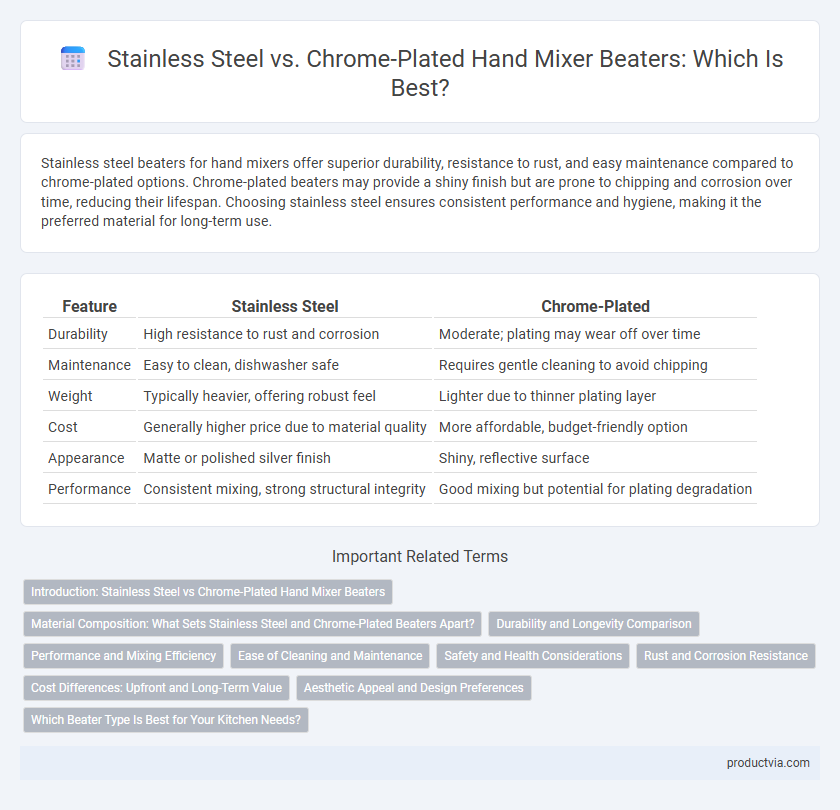Stainless steel beaters for hand mixers offer superior durability, resistance to rust, and easy maintenance compared to chrome-plated options. Chrome-plated beaters may provide a shiny finish but are prone to chipping and corrosion over time, reducing their lifespan. Choosing stainless steel ensures consistent performance and hygiene, making it the preferred material for long-term use.
Table of Comparison
| Feature | Stainless Steel | Chrome-Plated |
|---|---|---|
| Durability | High resistance to rust and corrosion | Moderate; plating may wear off over time |
| Maintenance | Easy to clean, dishwasher safe | Requires gentle cleaning to avoid chipping |
| Weight | Typically heavier, offering robust feel | Lighter due to thinner plating layer |
| Cost | Generally higher price due to material quality | More affordable, budget-friendly option |
| Appearance | Matte or polished silver finish | Shiny, reflective surface |
| Performance | Consistent mixing, strong structural integrity | Good mixing but potential for plating degradation |
Introduction: Stainless Steel vs Chrome-Plated Hand Mixer Beaters
Stainless steel hand mixer beaters are highly durable and resistant to rust, making them ideal for frequent use and easy cleaning. Chrome-plated beaters offer a shiny, attractive finish but may wear off over time, leading to potential corrosion. Choosing stainless steel ensures long-lasting performance and better hygiene for food preparation.
Material Composition: What Sets Stainless Steel and Chrome-Plated Beaters Apart?
Stainless steel beaters for hand mixers are composed primarily of iron, carbon, and chromium, providing superior corrosion resistance and durability compared to chrome-plated beaters, which feature a base metal coated with a thin layer of chromium. The chromium layer on chrome-plated beaters enhances scratch resistance and provides a shiny finish, but it can wear off over time, exposing the underlying metal to rust and damage. Stainless steel's homogeneous composition ensures consistent performance and longevity, making it a preferred choice for frequent use in demanding kitchen environments.
Durability and Longevity Comparison
Stainless steel beaters for hand mixers offer superior durability due to their resistance to rust, corrosion, and staining, ensuring long-lasting performance in frequent use. Chrome-plated beaters provide a shiny finish and some level of corrosion protection but tend to wear off over time, exposing the base metal which can lead to rust and reduced lifespan. Choosing stainless steel beaters enhances longevity and maintains structural integrity, making them a preferred option for heavy-duty mixing tasks.
Performance and Mixing Efficiency
Stainless steel beaters for hand mixers offer superior durability and resistance to corrosion, ensuring consistent mixing performance over time. Their non-porous surface prevents food residue buildup, enhancing hygiene and ease of cleaning, which directly impacts mixing efficiency. Chrome-plated beaters provide a smoother finish that reduces drag during mixing but may wear off with frequent use, potentially affecting long-term performance and consistency.
Ease of Cleaning and Maintenance
Stainless steel beaters for hand mixers provide superior ease of cleaning due to their non-porous surface that resists food buildup and corrosion. Chrome-plated beaters may develop peeling or rust over time, complicating maintenance and reducing durability. Choosing stainless steel ensures long-lasting hygiene and effortless upkeep for frequent kitchen use.
Safety and Health Considerations
Stainless steel hand mixer beaters offer superior resistance to rust, corrosion, and bacteria buildup, ensuring safer food preparation and improved hygiene. Chrome-plated beaters may chip or wear over time, potentially exposing metal layers that could contaminate ingredients or harbor harmful microbes. Choosing stainless steel enhances durability and reduces health risks associated with metal leaching or surface degradation.
Rust and Corrosion Resistance
Stainless steel beaters offer superior rust and corrosion resistance compared to chrome-plated ones due to their high chromium content, which forms a protective oxide layer. Chrome-plated beaters may initially resist rust, but over time, the plating can chip or wear off, exposing the underlying metal to corrosion. Choosing stainless steel beaters ensures longer durability and consistent performance in wet and acidic mixing environments.
Cost Differences: Upfront and Long-Term Value
Stainless steel beaters for hand mixers typically have a higher upfront cost due to their durability and resistance to rust, offering better long-term value by reducing the need for replacements. Chrome-plated beaters are usually more affordable initially but may wear out faster and require replacement sooner, increasing overall costs over time. Investing in stainless steel beaters ensures cost efficiency through longevity and sustained performance despite the higher initial price.
Aesthetic Appeal and Design Preferences
Stainless steel beaters offer a sleek, modern look with a matte finish that resists fingerprints and maintains its aesthetic appeal over time. Chrome-plated beaters provide a shiny, reflective surface that enhances visual brightness but may show scratches and wear more easily. Design preferences often favor stainless steel for durability and a contemporary style, while chrome plating appeals to those seeking a classic, polished appearance.
Which Beater Type Is Best for Your Kitchen Needs?
Stainless steel beaters for hand mixers offer superior durability, resistance to rust, and easy maintenance, making them ideal for frequent use in busy kitchens. Chrome-plated beaters provide a shiny finish and are typically more affordable but may chip or wear over time, requiring cautious use. Choosing stainless steel beaters ensures long-lasting performance and safety for diverse mixing tasks, while chrome-plated options suit occasional use with lighter ingredients.
Stainless steel vs Chrome-plated for hand mixer beaters Infographic

 productvia.com
productvia.com